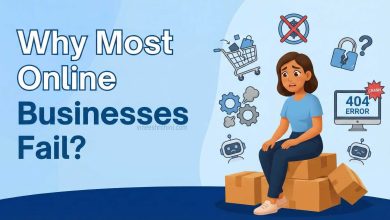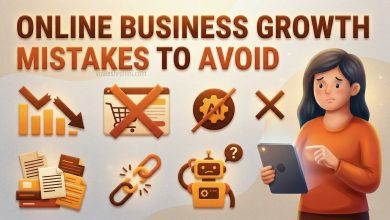How to Create and Sell Ebooks Online : Comprehensive Guide 2025
How to Create and Sell Ebooks Online : In the digital-first era of 2025, one of the most profitable and low-investment online business models is creating and selling eBooks. With increasing global access to smartphones, tablets, and eReaders, self-publishing has become more accessible than ever. Whether you’re an aspiring author, digital marketer, coach, educator, or entrepreneur, selling eBooks online can be a consistent income stream with high scalability.
Table of Contents
In this comprehensive guide, we’ll walk you through the entire process—from ideation to publishing and marketing—while using high-reaching keywords relevant to today’s digital economy.
Why Sell eBooks Online in 2025?

Before diving into the step-by-step process, let’s understand why eBooks are booming in 2025:
- Low Startup Cost: You only need a computer and an internet connection to begin.
- High Profit Margins: There are no printing or shipping costs, and once an eBook is created, it can be sold repeatedly.
- Passive Income Potential: Once live, eBooks can generate ongoing revenue with minimal updates.
- Global Reach: Sell your eBook worldwide through platforms like Amazon Kindle, Gumroad, or your own website.
- Authority Building: An eBook can establish you as an expert in your niche.
Also Read : How to Sell Ebooks Profitably
Step 1: Choosing the Right Niche and Topic
Your eBook must solve a problem, answer a question, or provide value to a specific target audience. Choosing the right niche is critical to ensuring demand and conversions.
High-Demand eBook Niches in 2025:
- Personal Finance & Money Management
- Digital Marketing & Online Business
- Self-Improvement & Productivity
- Health, Fitness & Diet
- Parenting & Relationships
- Coding & Technology Guides
- Freelancing & Remote Work Tips
Tips to Find Hot Topics:
- Use tools like Google Trends, Ubersuggest, or AnswerThePublic.
- Research popular questions on Quora or Reddit.
- Look at bestsellers in your category on Amazon Kindle Store.
- Analyze keywords using SEMrush or Ahrefs for search volume.
Step 2: Research and Outline Your Content
Once you’ve chosen a topic, create a detailed outline. Your eBook must deliver structured, actionable, and comprehensive content.
Outline Template:
- Title Page
- Copyright and Disclaimer
- Table of Contents
- Introduction
- Chapter 1 – Define the Problem
- Chapter 2 – Discuss Background
- Chapter 3 – Solution or Process
- Chapter 4 – Case Studies or Examples
- Chapter 5 – Tips, Tools, or Resources
- Chapter 6 – Conclusion & Call-to-Action
Pro Tip: Add value through infographics, worksheets, and action checklists to increase reader engagement.
Step 3: Writing the eBook
Now it’s time to write your eBook. You can write it yourself, hire a ghostwriter, or use AI-assisted tools like ChatGPT, Jasper, or Writesonic.
Best Practices for Writing:
- Use short paragraphs and conversational tone
- Add bullet points for readability
- Include statistics and credible sources
- Keep the tone aligned with your audience (formal/informal)
- Always have a clear takeaway at the end of each chapter
Writing Tools You Can Use:
- Google Docs (collaboration & backup)
- Grammarly (grammar & clarity)
- Hemingway Editor (readability)
- Canva Docs (design-integrated writing)
Step 4: Designing a Professional eBook Layout

Design is crucial. A poorly designed eBook, no matter how informative, will struggle to gain traction.
Tools for eBook Design:
- Canva Pro – Intuitive and perfect for non-designers
- Adobe InDesign – Advanced layout customization
- Designrr.io – Convert blogs or content into eBooks instantly
- Visme – Great for interactive and visually appealing eBooks
Design Elements to Consider:
- Cover design (must be high-impact and genre-appropriate)
- Readable font style (avoid cursive or overly stylized fonts)
- Chapter headers and page numbers
- Images, charts, and callouts to break text blocks
- Add your brand colors and logo for recognition
Step 5: Formatting Your eBook
For your eBook to be accepted across platforms, it must be correctly formatted. Use these formats based on where you want to sell:
- PDF – Best for direct sales and lead magnets
- EPUB – For Apple Books, Google Play, and Kobo
- MOBI – Formerly used by Amazon Kindle (now Kindle prefers EPUB)
Tip: Use tools like Calibre or Reedsy Book Editor to convert between formats seamlessly.
Step 6: Setting the Right Price
Pricing your eBook strategically can influence its sales.
Pricing Models in 2025:
- Low-Ticket (₹99 – ₹299): Great for volume sales on Amazon or Gumroad
- Mid-Ticket (₹499 – ₹999): Good for niche-specific, high-value eBooks
- High-Ticket (₹1000+): Suitable if bundled with bonuses like video lessons or templates
Consider:
- Competitor pricing
- Perceived value
- Audience size and purchasing power
- Offering discounts during launch to encourage reviews
Step 7: Choosing Where to Sell Your eBook
There are multiple online platforms in 2025 to sell your eBook, depending on your goals.
Top Platforms to Sell eBooks:
- Amazon Kindle Direct Publishing (KDP):
- Huge global reach
- Royalties up to 70%
- Built-in audience
- Gumroad:
- Direct-to-customer selling
- Ideal for creators
- Easy integration with email tools
- Payhip:
- Simple digital product storefront
- Great for indie authors
- Google Play Books / Apple Books:
- Reach mobile readers
- Royalty-based income
- Your Own Website:
- Full control over pricing, branding, and marketing
- Use platforms like Shopify, Wix, or WordPress + WooCommerce
Tip: Selling via your own website gives you full profit margin and email leads.
Step 8: Marketing and Promotion Strategies
Creating an eBook is only half the battle. The real magic lies in strategic marketing. Leverage multiple digital marketing channels to maximize reach.
Best eBook Marketing Strategies in 2025:
- Email Marketing:
- Offer a free chapter or checklist in exchange for email
- Use autoresponders (MailerLite, ConvertKit, etc.)
- Send launch and offer campaigns
- Content Marketing:
- Start a blog or YouTube channel related to your eBook niche
- Repurpose your eBook content into bite-sized posts
- Social Media Marketing:
- Share tips, quotes, and snippets from your book
- Use Instagram Reels, LinkedIn Posts, and Twitter Threads
- Collaborate with influencers
- Paid Advertising:
- Use Facebook Ads with lead magnets
- Run Amazon Ads (especially for Kindle books)
- Google Ads targeting keywords like “best eBook on [topic]”
- SEO Optimization:
- Optimize your eBook landing page for keywords
- Write SEO-friendly blogs linking to your eBook
- Submit your eBook to directories
- Affiliate Marketing:
- Offer a commission to other creators or bloggers
- Use Gumroad or ThriveCart affiliate system
- Webinars and Podcasts:
- Host a live session explaining your eBook concept
- Offer exclusive discounts to attendees
Also Read : The Most Profitable Digital Products to Sell
Step 9: Gathering Reviews and Testimonials
Social proof significantly boosts eBook conversions.
Ways to Get Reviews:
- Offer free review copies to beta readers
- Ask for reviews on Amazon or your website
- Encourage email subscribers to provide feedback
- Display testimonials on landing pages and social media
Pro Tip: Use tools like VideoAsk or Loom to gather video testimonials.
Step 10: Scaling Your eBook Business
Once your first eBook is successful, the opportunity to scale is massive.
Ways to Scale:
- Convert eBook into a course, audiobook, or workshop
- Translate your eBook into other languages
- Create an eBook series
- Bundle multiple eBooks for higher pricing
- License your content to institutions or companies
- Use your eBook as a lead magnet for a high-ticket offer
High-Reaching Keywords to Include in Your Content or Titles:
- Sell eBooks online in India 2025
- Best eBook publishing platforms
- How to price your eBook for profit
- eBook business ideas for beginners
- Make money writing eBooks
- How to market your eBook on social media
- Digital products to sell in 2025
- Passive income from eBooks
- Kindle publishing guide India
- How to self-publish an eBook successfully
How to Create and Sell Ebooks Online – Conclusion:

Creating and selling eBooks online in 2025 is more than just a side hustle—it’s a powerful, scalable business model that can fuel your brand, authority, and passive income. With the right strategy—from topic selection to content creation, formatting, publishing, and marketing—you can turn your knowledge into a digital asset that works for you around the clock.
Buy Now : Ecommerce Website With 100 Products
Whether you’re looking to build authority, create passive income, or grow a full-scale online brand, an eBook is your best digital starting point.
Disclaimer: This content is for educational purposes only. Results may vary based on individual execution, marketing efforts, and industry conditions.
Keywords : How to Create and Sell Ebooks Online – How to Create and Sell Ebooks Online 2025 – How to Create and Sell Ebooks Online Guide



